Impact of Ayushman Bharat: A Comprehensive Review of India’s Healthcare Initiative
Impact of Ayushman Bharat: A Comprehensive Review of India’s Healthcare Initiative
Published on :- May 3rd, 2023
April 7th is observed as World Health Day. This year, the World Health Organization observed its 75th anniversary. The theme for 2023 was “Health for All”. This day is observed to promote health and safety, highlight health challenges and serve the vulnerable so that everyone, everywhere, can attain the highest level of health and well-being.
To commemorate this day, we are looking at ‘Ayushman Bharat’ - a flagship scheme of the Government of India, which was launched as recommended by the National Health Policy 2017 to achieve the vision of Universal Health Coverage (UHC).
Introduction to Ayushman Bharat
The Government of India launched Ayushman Bharat in 2018 to expand universal health coverage, especially to rural and vulnerable populations. This initiative has an underlying commitment, which is to "leave no one behind”, and has been designed to meet SDG 3, Target 3.8, i.e. Achieve universal health coverage, including financial risk protection, access to quality essential health care services and access to safe, effective, quality.
Ayushman Bharat (AB) aims to undertake interventions to holistically address health at primary, secondary, and tertiary levels. The main aim is to provide essential health services throughout the country through four pillars of this programme:
1. Health and Wellness Centres (HWCs)
The first component pertains to the creation of 1.5 Lakh Health and Wellness Centres (HWCs), which brings healthcare closer to the homes of the people. These centres provide Comprehensive Primary Health Care (CPHC), covering both maternal and child health services and non-communicable diseases, including free essential drugs and diagnostic services.
In FY 2018-2019, a budget of 1200 crore was allocated as a flagship programme to Ayushman Bharat - Health & Wellness Centres.
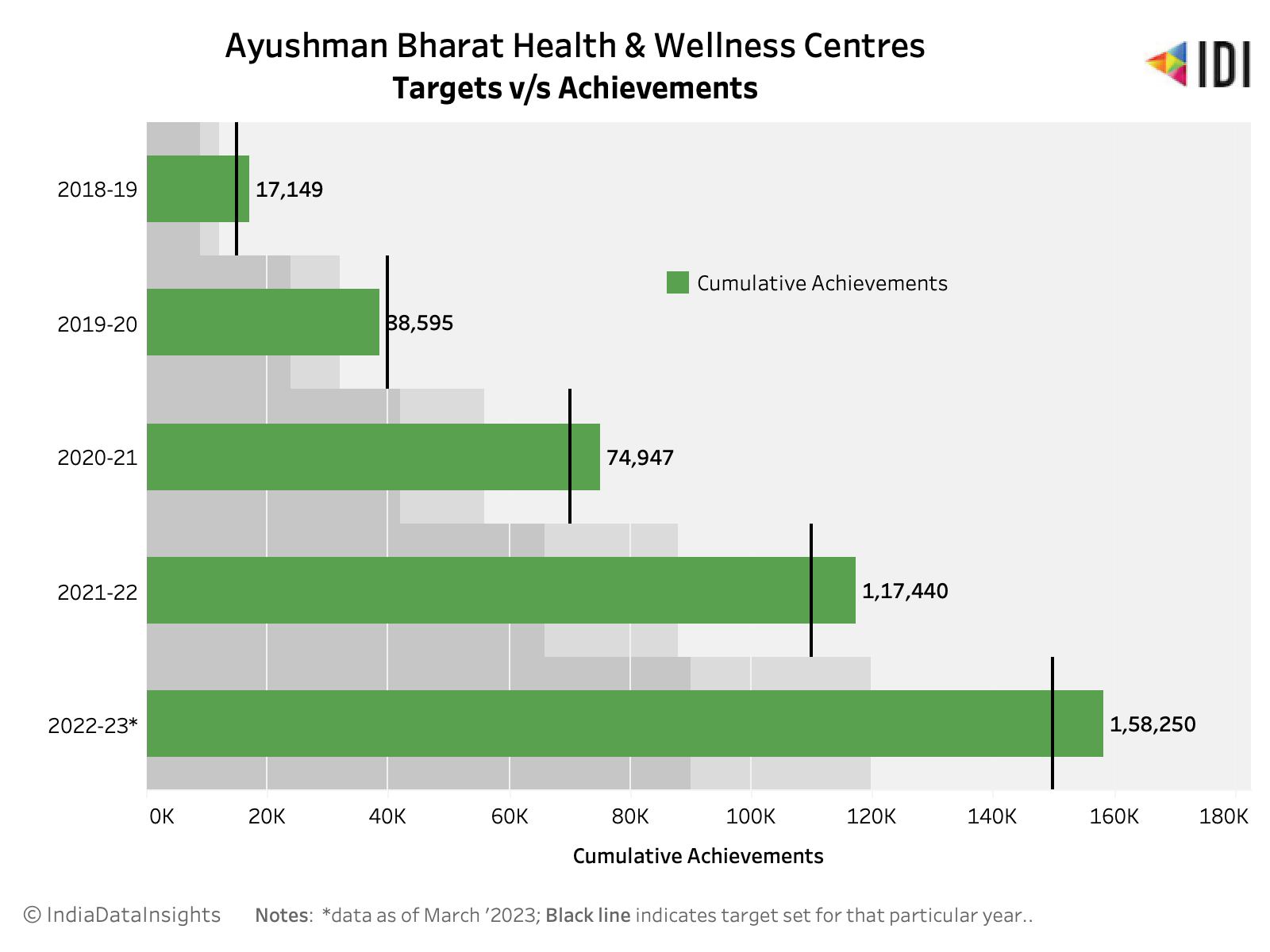
A notable landmark of 1.5 Lakh Ayushman Bharat Health & Wellness centres has been surpassed in 2023. These centres were operationalised within India to provide the citizens with easy access to healthcare. Since the establishment of HWCs, the program has achieved more than
~86.90 crore screenings for Non-communicable diseases
~9.3 crore teleconsultations were provided
~135 crore cumulative footfalls
~1.60 crore wellness sessions at HWCs.
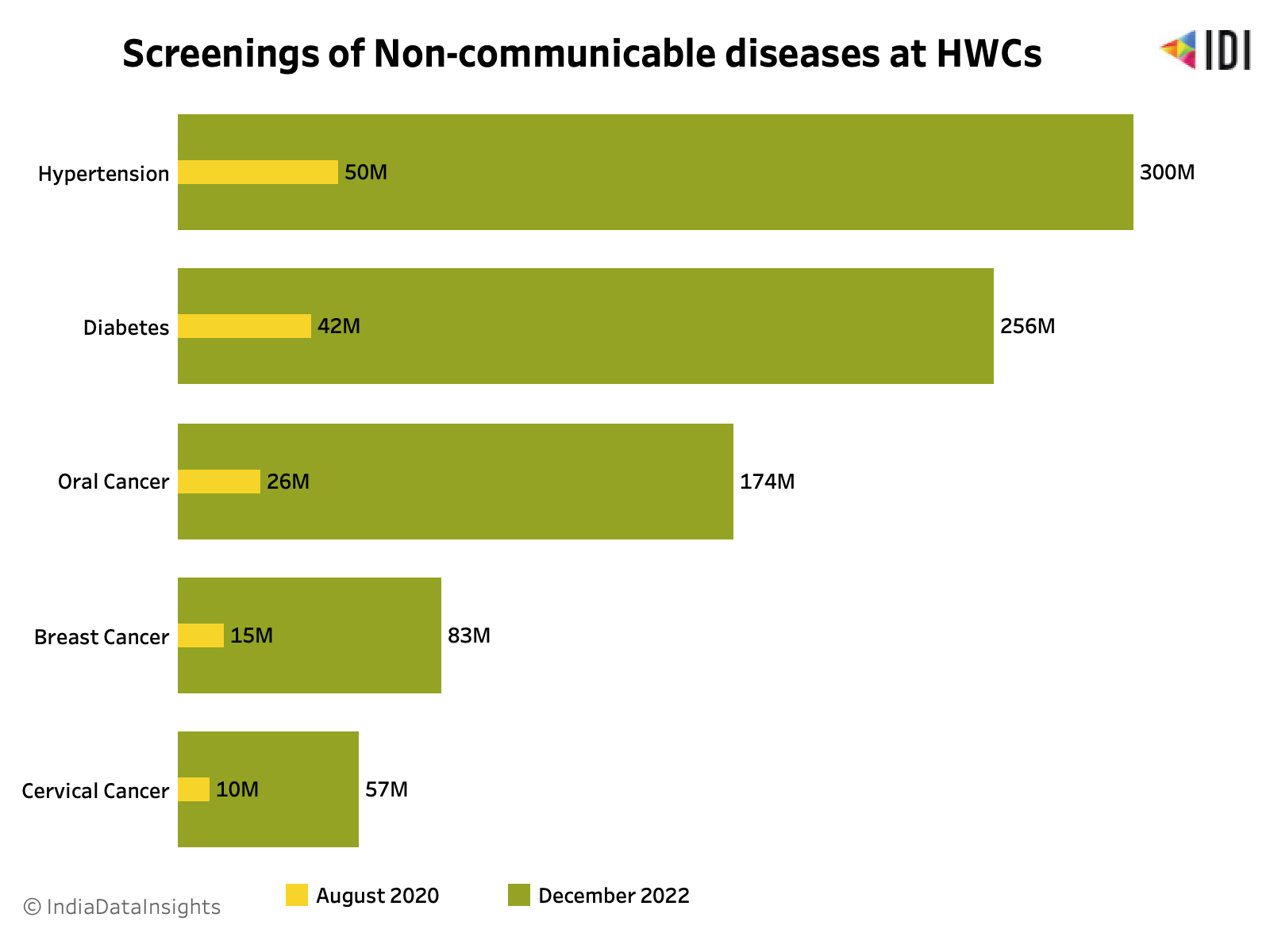 An important aspect of HWCs was to provide comprehensive healthcare for Non-communicable diseases (NCDs). During the period of Aug 2020 to Dec 2022 (25 months), remarkable progress was seen in the number of screenings for NCDs.
An important aspect of HWCs was to provide comprehensive healthcare for Non-communicable diseases (NCDs). During the period of Aug 2020 to Dec 2022 (25 months), remarkable progress was seen in the number of screenings for NCDs. While the total number of screenings went up by 510%, a major jump was seen in screenings for Oral Cancer, which increased by 148 million (570% increase).
2. Pradhan Mantri Jan Arogya Yojana (PM-JAY)The second important component of Aayushman Bharat is the ‘Pradhan Mantri Jan Arogya Yojana - also popularly known as PM-JAY. This scheme was launched on 23 September 2018, with the vision of achieving SDG Target 3.8 - ensuring financial protection against catastrophic health expenditure and access to affordable and quality healthcare for all.
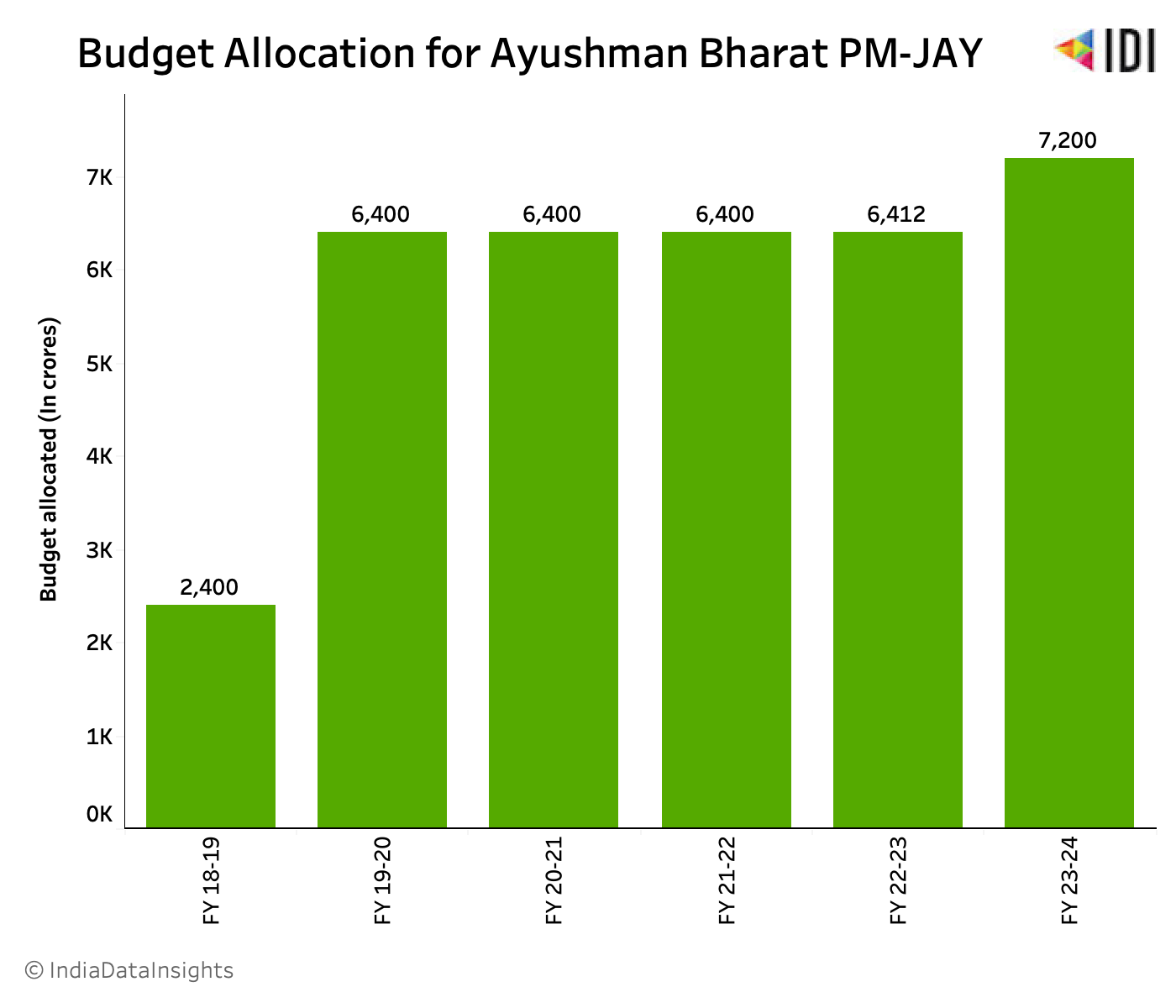
The year-on-year budget allocation of Ayushman Bharat PM-JAY rose significantly from 2400 crores in FY 2018-19 to 6400 crores in FY 2019-20. Though the budget allocation remained constant for the last 4 years, the budget allocation was increased to 7200 crores in FY 2023-24 - a threefold increase since its inception in 2018-19.
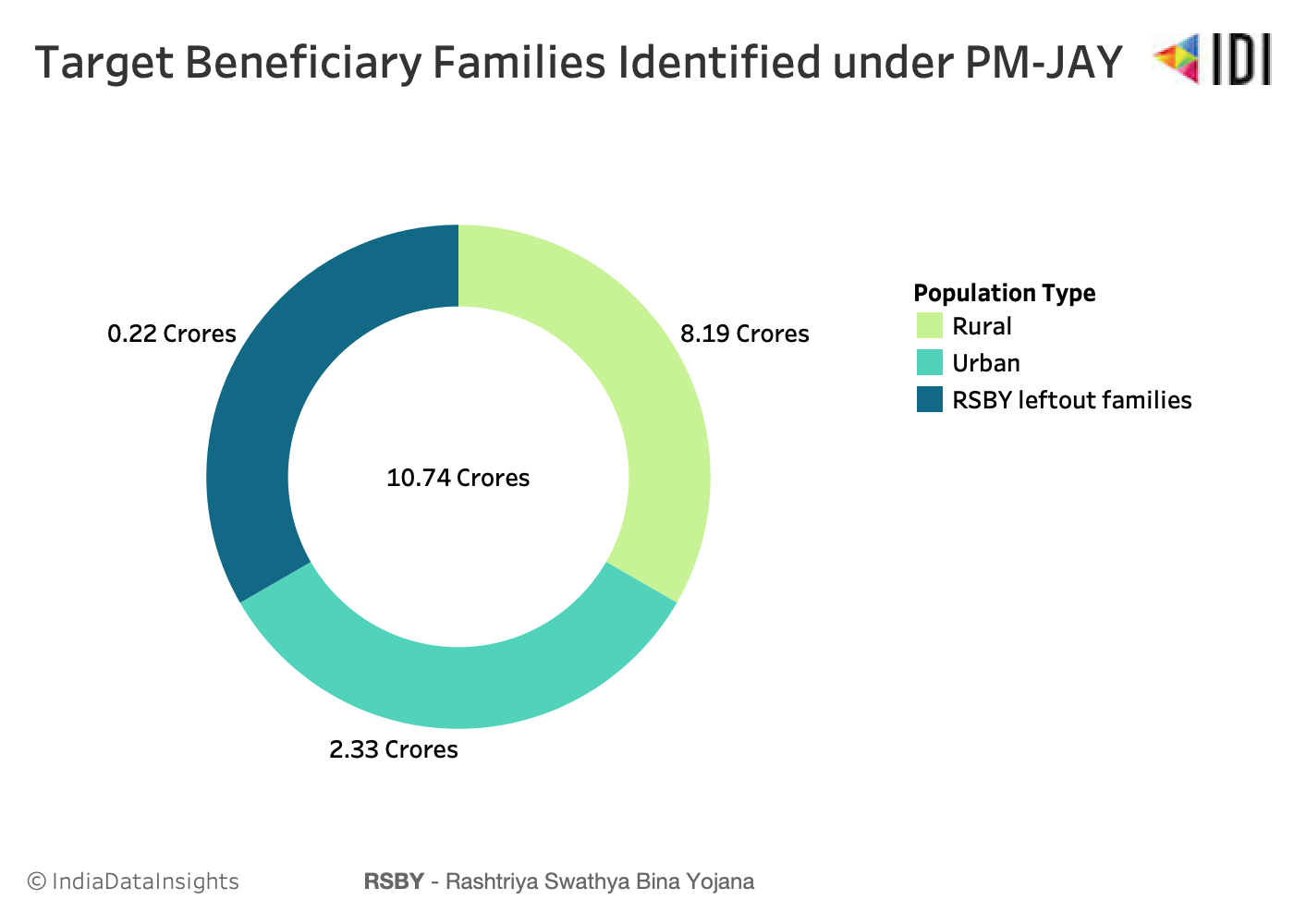
PM-JAY is the largest health assurance scheme in the world, covering over 10.74 crore poor and vulnerable families (~50 crore beneficiaries) that constitute the bottom 40% of the Indian population who will receive an annual health coverage of Rs. 5 lakhs per family, for secondary and tertiary care hospitalisation.
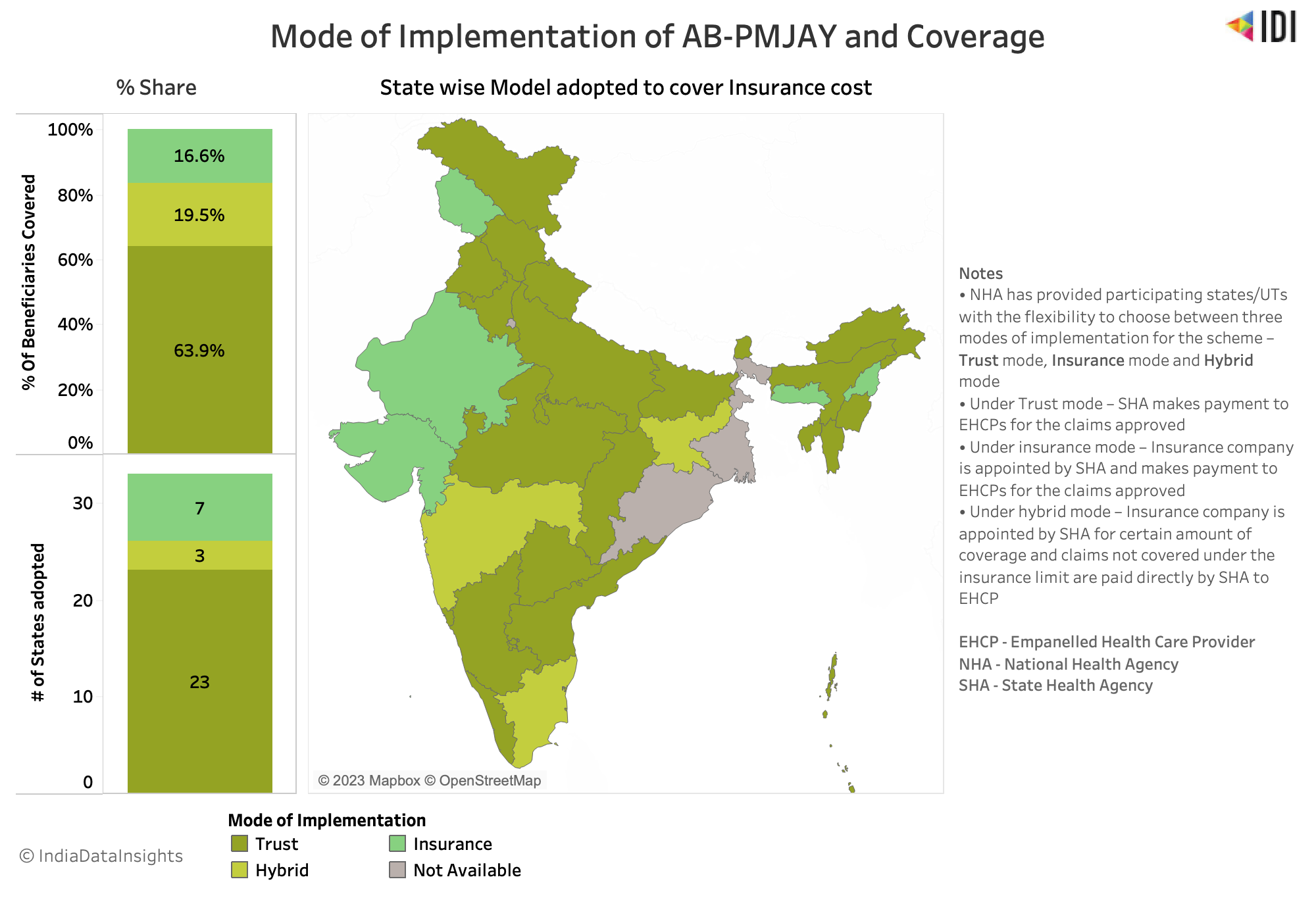
PM-JAY provides the States with the flexibility to choose their implementation. The different modes of implementation are:
So far, 33 States have adopted the Ayushman Bharat PM-JAY scheme, and these states implement the scheme in different modes. 23 states have adopted the Trust mode, which caters to 63.9 % of the beneficiaries in India. Three states viz. Jharkhand, Maharashtra, and Tamil Nadu have adopted the Hybrid mode of implementation, which contributes to 19.5% of the beneficiaries.
Progress of PM-JAY in IndiaThe PM-JAY beneficiaries get an e-card called ‘Ayushman Bharat Card’ that can be used to avail services at an empanelled hospital (public or private) anywhere in the country. As of March 2023, more than 21 crore Ayushman Bharat cards have been created, and 28,561 hospitals are empanelled under PM-JAY in India, and the total amount incurred under PM-JAY is INR 53,942.7 crores.
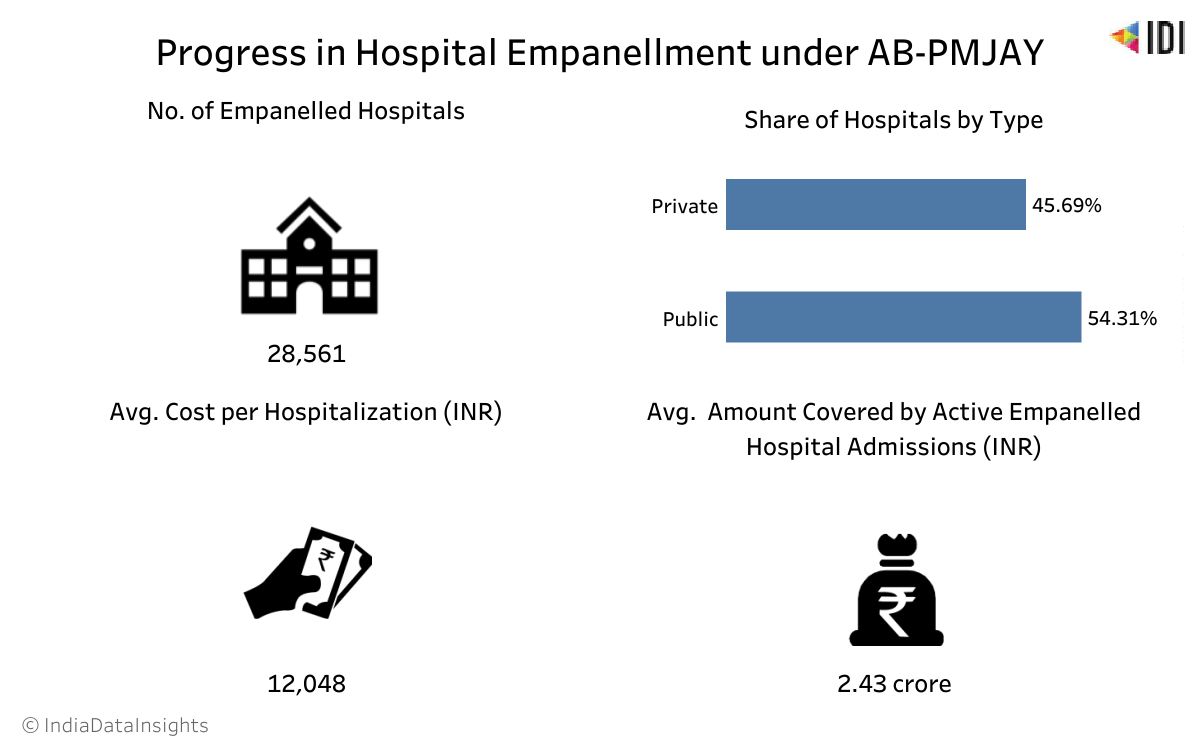
Since the inception of PM-JAY in 2018, the trend of Ayushman Bharat card creation has been erratic. The impact of COVID-19 can be seen in the trends of both card creation and hospital admissions. While new card creations slowed down during the first wave (Apr - Nov 2020), the number of hospital admissions spiked during the second wave.
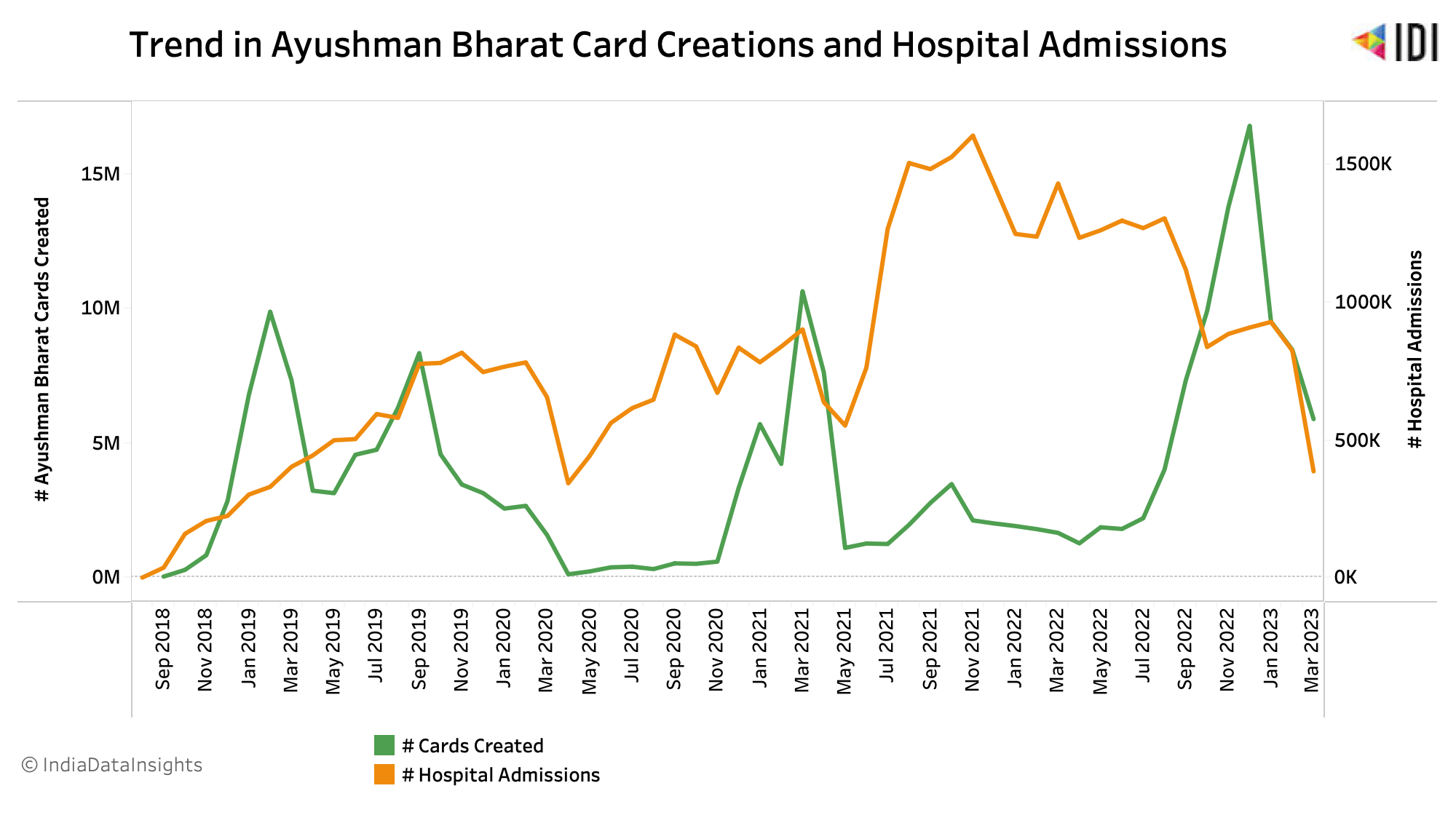
As of March 2023, ~21.33 crore Ayushman Bha0rat cards have been created and ~4.46 crore hospital admissions (~1 admission every 5 cards). More than 50% of the card share is from five large states - Madhya Pradesh (16.6%), Uttar Pradesh (12.2%), Gujarat (8.3%), Chhattisgarh (7.9%) and Karnataka (6.4%).
Share of hospital admission is found to be higher in the Southern states such as Tamil Nadu and Kerala, viz 19.5% and 10.9 %, respectively. This indicates that awareness of the benefits of the Ayushman Bharat scheme seems to be higher among the rural beneficiary families in the southern region.
Highly populous states like Bihar and Maharashtra have very low percentages of Ayushman Bharat card creation as well as hospital admissions. In spite of having a higher share of Ayushman Bharat cards in the states of Uttar Pradesh and Madhya Pradesh, the hospital admission shares are low - 4.4% and 5.7%, respectively.
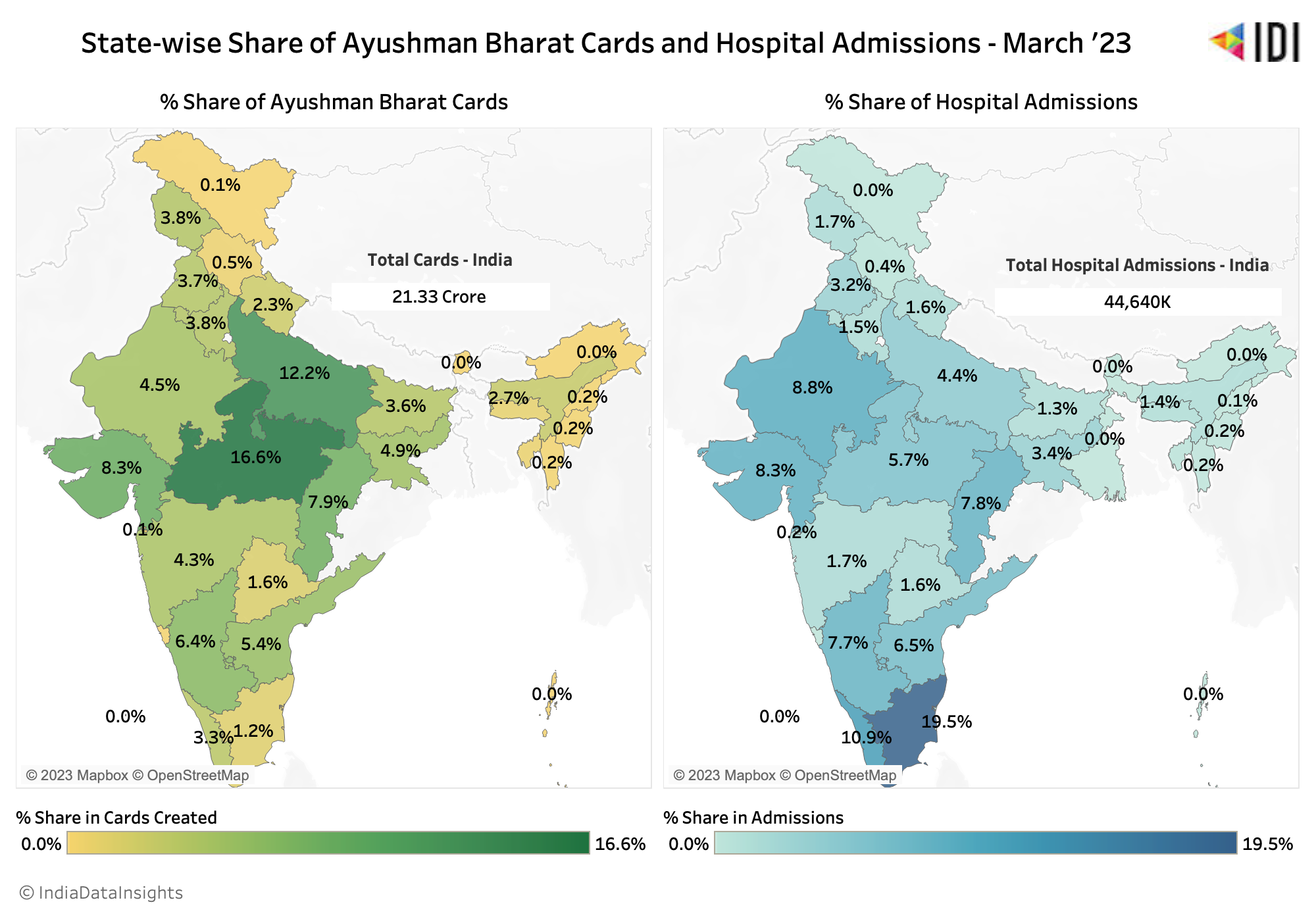
While the majority of the states have very low hospital admissions per 100 Ayushman Bharat cards -ranging between 0 to 25. Tamil Nadu topped with ~331 Hospital admissions per 100 Ayushman Bharat cards followed by Kerala (~68), Rajasthan (~41) and Meghalaya(~32) per 100 cards created.
The load on empanelled hospitals seems to be higher in the states of Bihar and Assam. These states have more than 20 thousand beneficiary families per empanelled hospital.On the other hand, the southern states have approximately only 3 thousand beneficiary families per empanelled hospital.
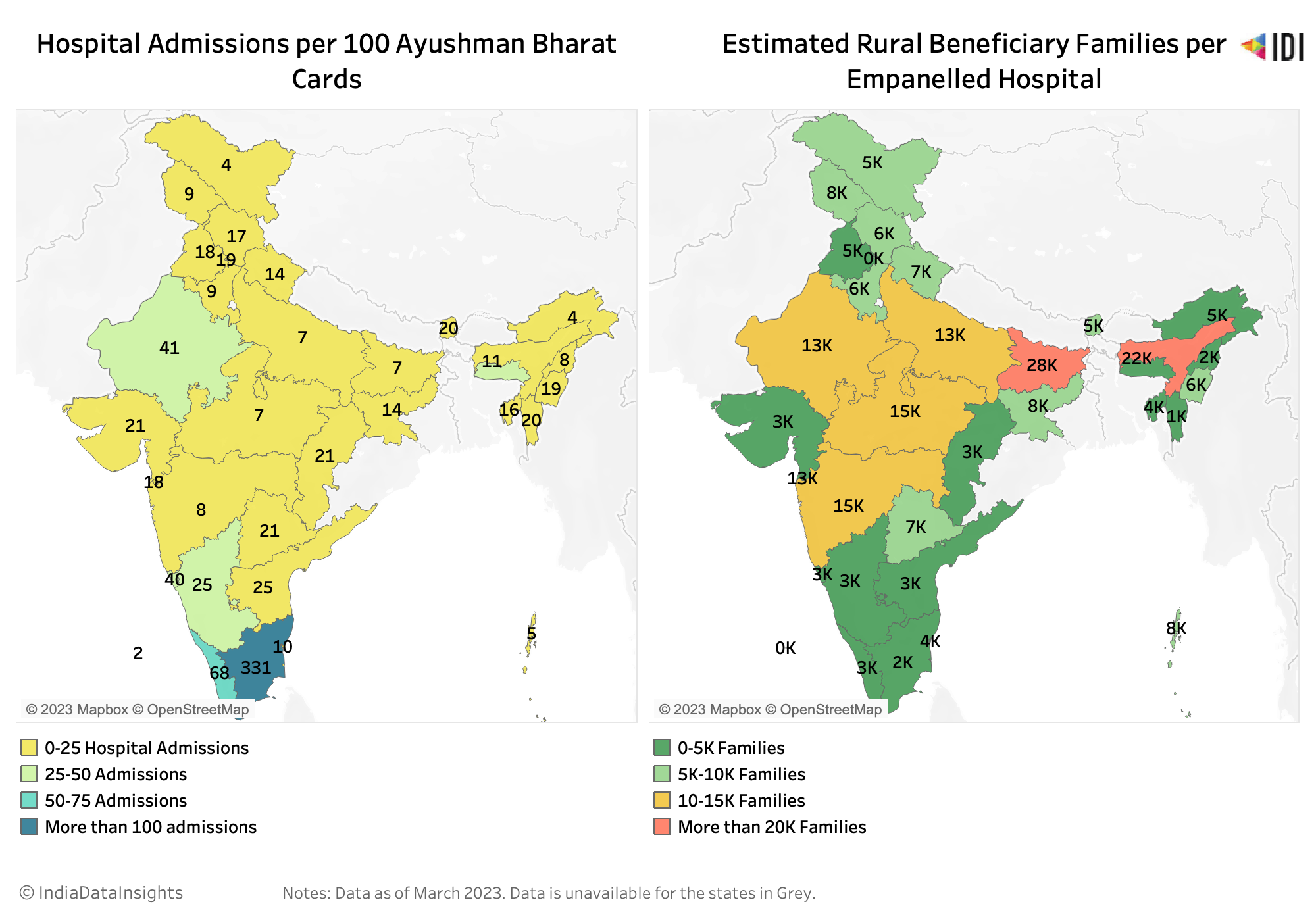
While there are a total of 28,561 hospitals were empanelled under PM-JAY, a lot of these seem to be inactive. As of Mar ‘23, 22% of these hospitals were inactive, further increasing the load on the active hospitals. ~79% of empanelled hospitals in Arunachal Pradesh and more than 50% of empanelled hospitals in Rajasthan, Andhra Pradesh, and Manipur are now inactive.
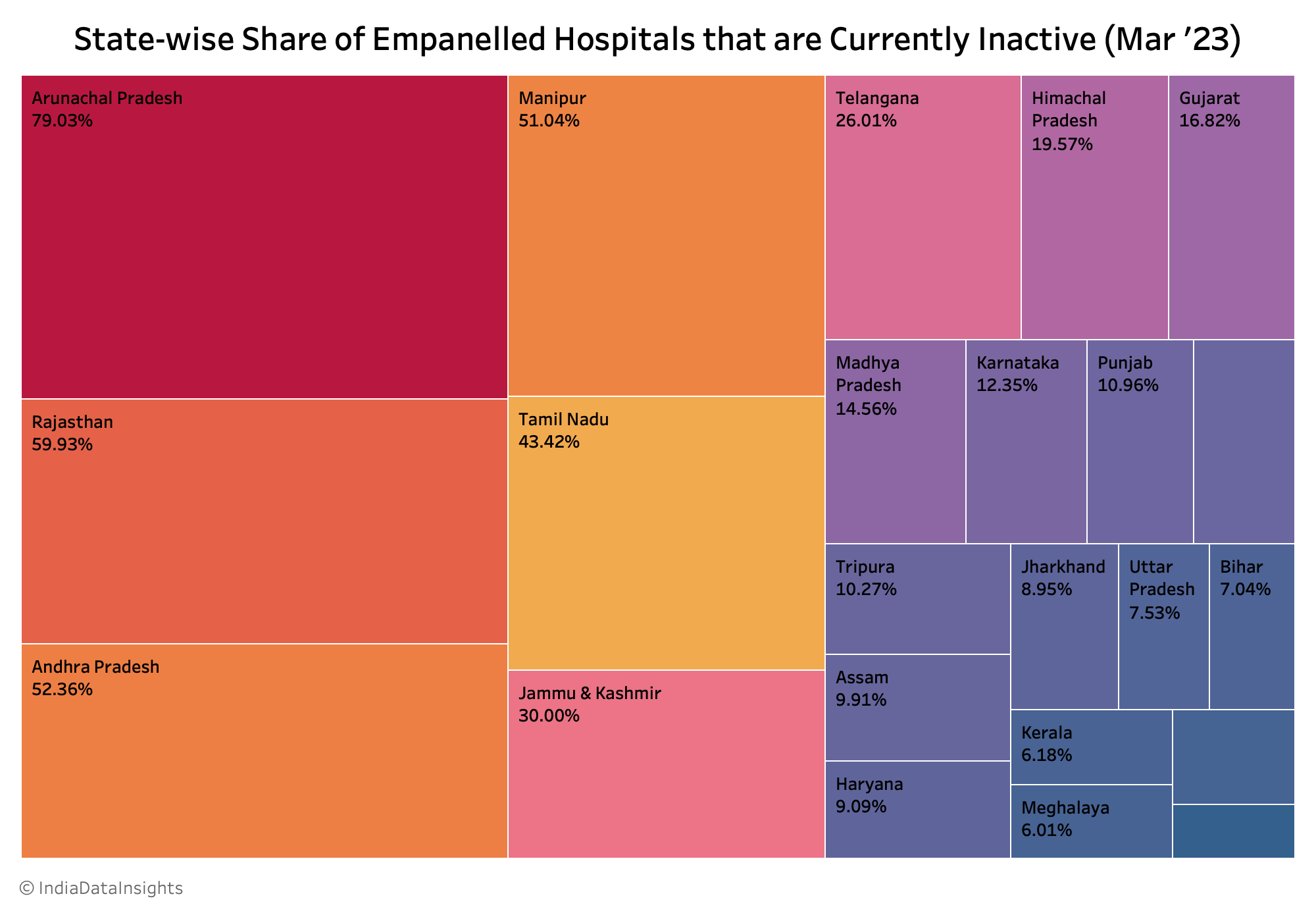 While the PM-JAY scheme provides access to comprehensive healthcare, the most popular services availed were General Medicine (40%) followed by services for Infectious Diseases (15.7%).
While the PM-JAY scheme provides access to comprehensive healthcare, the most popular services availed were General Medicine (40%) followed by services for Infectious Diseases (15.7%).
Among the procedures, the most popular procedure undertaken has been Hemodialysis (~40.5%) followed by screening tests for COVID-19 Infection(~25.8%).
3. Ayushman Bharat Digital Mission (ABDM)
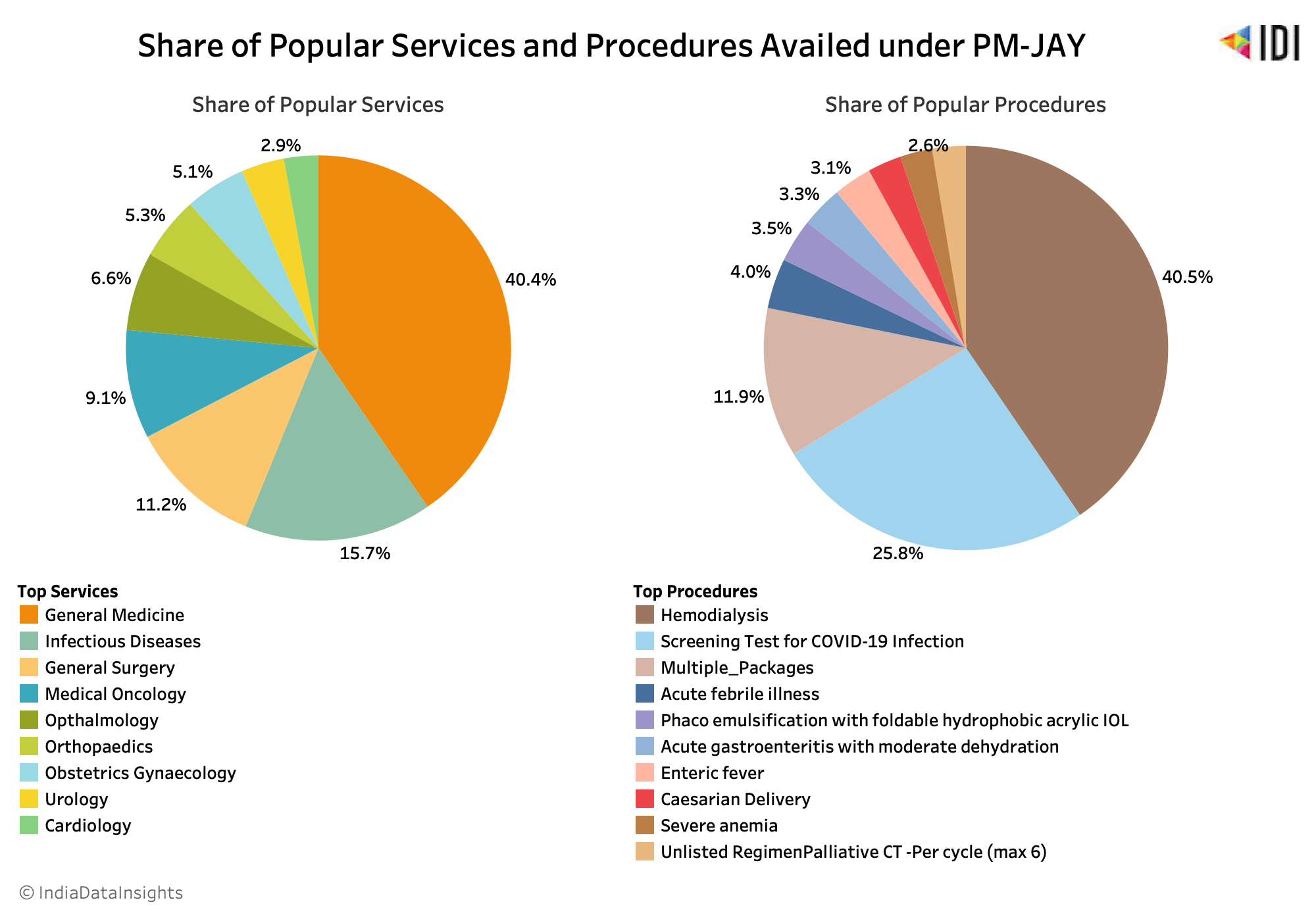
3. Ayushman Bharat Digital Mission (ABDM)
4. Pradhan Mantri-Ayushman Bharat Health Infrastructure Mission (PM-ABHIM)
This mission, earlier known as Pradhan Mantri Atma Nirbhar Swasth Bharat Yojana scheme, was provided an outlay of about Rs. 64,180 crores till FY 2025-26 and was launched on 25 October, 2021. This is the largest pan-India scheme for strengthening healthcare infrastructure across the country. The measures under the scheme focus on developing capacities of health systems and institutions across the continuum of care at all levels viz. primary, secondary and tertiary and on preparing health systems for effective response to current and future pandemics/disasters.
Setting up these 4 pillars has paved the path to an underlying commitment of India’s goal for SDG 3 to "leave no one behind” and the coming years will determine whether every rural beneficiary is covered and benefited from this.
Additional resources:
